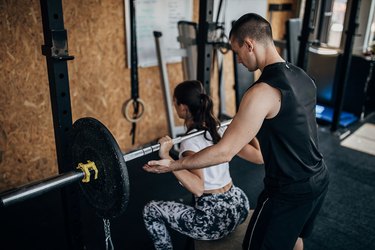
As fitness professionals, many certified trainers easily get caught up in using the textbook phrases and exercise jargon that come with knowing their stuff. But just because these training cues make sense to them, it doesn't necessarily mean they will click for you, too.
Unfortunately, some training cues don't always translate well in real life, so the average person may take them literally, which can lead to pain and injury.
Video of the Day
Video of the Day
Learn which exercises certified trainers often cue improperly and how to fix them so you can avoid injury.
1. Squats
The Error: Keeping the Back Too Straight
A common mistake trainers make with squats is keeping the back too straight, says New York-based physical therapist and certified strength and conditioning coach Melissa Garcia, DPT, CSCS.
"A lot of errors with this exercise stem from the belief that the back needs to be 'as straight as possible,' so many people will tend to try to maintain an upright posture throughout the entire motion," Garcia says.
You definitely don't want a rounded back, but you also don't want to push your chest and midsection too far forward, either. This causes your butt to lift too far up and out, which can cause lower back pain.
This mistake makes it even harder to do a squat with perfect form when you add weight, Garcia says.
Fix It
Contract your core by tightening your abdominals and think about sitting back into an invisible chair. Keep your head and chest up naturally as you shift your weight slightly back into your heels.
2. Lunges
The Error: Always Keeping the Toes Behind the Knee
You might have heard your trainer say it's best to keep the knees behind the toes while lunging. Although this cue is meant to help prevent knee pain, it may be a little overused and (in some cases) unnecessary, according to Garcia.
"Even without the presence of pain, people will tend to avoid letting the knee travel over the toe, purposefully reducing their range of motion," she says. "Although everyone's lunge will look a little different, we should not be avoiding this motion!"
That's not to say that keeping the knee behind the toes is incorrect either, she says. The key to a perfect lunge is control and balance, allowing your knee to move as far forward as it safely can.
Fix It
Keep your weight balanced through your whole foot, not just your heels, Garcia says. As you lower to the ground, allow your knees to travel where they need to go.
3. Kettlebell Swings
The Error: Using the Arms to Lift the Weight
Kettlebell swings are a great combo of cardio and strength in one move, but they are often taught and performed incorrectly, according to Sam Chan, DPT, a New York-based physical therapist. Too often, Chan sees people — including certified trainers — use too much of their arms and shoulders to lift the kettlebell.
"Many people swing their arms to bring the kettlebell up, rather than allowing the legs to do the work," he says. "A kettlebell swing is a lower-body exercise — the arms are just coming along for the ride."
Fix It
Imagine squeezing a dollar bill between in your armpits, Chan suggests. This keeps you from swinging the weight with your arms and forces you to use your legs and hips. The kettlebell should feel weightless in your hands.
4. Plank
The Error: Keeping a Straight Line from Head to Heels
Although it's important to keep different parts of your body aligned during a plank, your body won't necessarily look like it's in a literal straight line.
"What is commonly missed is everything in between, literally," she says. "The shoulder blades, glutes and trunk should be actively engaged rather than letting it slump."
The key is to squeeze the shoulder blades, glutes and trunk. For some, this may cause the body to curve at the top, making the upper back look a little hunched.
Fix It
"To correct this posture, I tell my clients to push into the ground and feel the shoulder blades engage against the ribcage," Garcia says. "Pull the bellybutton toward the ceiling while keeping the hips level."
5. Shoulder Press
The Error: Pressing Straight Overhead
Personal trainers tend to overemphasize pressing the weights straight overhead when doing a shoulder press, but this cue can cause people to excessively arch the lower back, Garcia says.
Most people — trainers included — don't have enough shoulder mobility to press a pair of dumbbells straight up above their shoulders. So when they try to get the weights up, their lower back arches in an attempt to increase the range of motion overhead, she says.
You definitely want to press the weight up as straight as possible, but there are a few simple solutions that can help offset the lack of mobility.
Fix It
Try doing a landmine tall kneeling press, in which you press the barbell overhead with your torso leaning slightly forward. Unlike a traditional shoulder press, the landmine press doesn't require you to push the weight directly overhead, so you don't need as much mobility. This also helps protect the lower back and prevents arching.